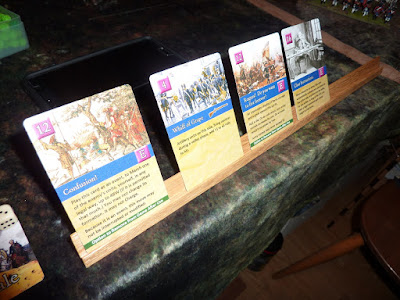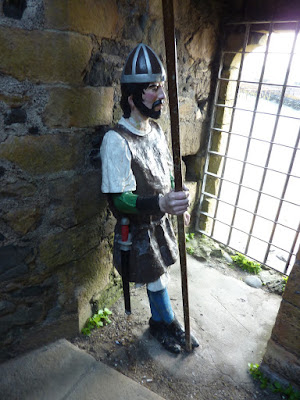 |
| Landwehr vs French lights - they typified the Prussian performance on the day - valiant but not very effective |
As I recall, at Real Plancenoit, the town changed hands repeatedly during the evening, the French called in more and more prestigious contingents of Imperial Guard, but were eventually overwhelmed. The Prussians thus appeared behind the French right flank on the main Waterloo battlefield, and the whole French army, which was already pretty much on its last legs, routed. [If you don't happen to agree with my quick summary of the history, please accept my admiration for your scholarship - I'm sure you're right. No need to put me straight.]
In our game, the Prussians obviously were going to have very severe problems getting the French out of the little town. After some initial thoughts about amending the scenario a little, we decided to stick with the one on the website, including the bonus Victory Banners available for possession of parts of the town. As Prussian commander, I had wild thoughts of ignoring the town - just demonstrating against it - and trying to mop up enough of the French troops elsewhere to scrape victory - if they shifted anyone to support their (left) flank then an assault on the town might make more sense. However, since this would make a nonsense of the historical battle, I stuck with the script, and assaulted Plancenoit like a good'un. Not so good, in fact.
The French commander (Comte Lobau, aka Stryker) drew some excellent cards early, including one which enabled him to rush his reserves up into the town, so that by the time I got my first attack under way the place was stuffed with Old Guard, Young Guard and all shades of high-quality soldiery, and the challenge had become even more - well, challenging. Very quickly, that first attack fizzled out, and there didn't seem to be much to be gained by just going back in again. I had a bigger army, but I was losing them very quickly.
Also, the movement of the French reserves into the town meant that I no longer had scope to defeat enough units on my right flank to tip the balance back. However, I went ahead and attacked the French left, and had a little more success, while my continuing intermittent assaults on Plancenoit itself gained occasional footholds, but always short-lived. At one point I was 8-1 down on VBs (9 for the win), but a (very lucky) victory over a battalion of Old Guard (who were out in the open - definitely the high spot of an otherwise bleak day for the Prussians) and some success on my right got things back to 8-4, before the French, quite correctly and justifiably, won their final banner.
No complaints from me - I was disappointed by my light cavalry (that must be some kind of epitaph), who were just outclassed by their opponents, and my artillery achieved nothing at all - hopeless, but once again the Landwehr demonstrated a magical ability to roll good dice. We had a discussion afterwards over whether the basic superiority of the French troops, as set out in the standard national tables in C&CN, is maybe overstated for the 1815 period, but that is just a fun debate. My lot were, to coin a military phrase, whupped on the day.
My thanks and compliments to Goya, who hosted the action and umpired (and fed us, splendidly), and Stryker, who commanded the French force with his customary élan. Great day out - a huge amount of fun.
History is wrecked, the French probably did go on to gain their celebrated victory at the Battle of Mont St Jean after all. Conky Atty may invent whatever versions of the day he wishes. Neither night nor Blücher arrived early enough to save him...
**** Recommend you also link to Stryker's account of the day, which has better photos *****
 |
| Middle of the Prussian position - Plancenoit just visible at the top of the picture |
 |
| Some of the troops on the French left - I'd have done better against these... |
 |
| Quality everywhere - the French reserves are rushed up - strictly, these are Guard Fusiliers, but they were Young Guard for the day - that must be General Duhèsme, then |
 |
| Script for the day - send in more heroes... |
 |
| ...and occasionally someone would get a toe in the town, but briefly; fleetingly |
 |
| "Let's get this straight - you want us to flush them out of there - is that what you said...?" |
 |
| The Prussians still have troops in decent shape, but none of them is keen to attack the town again |
 |
| After a while, a gap opened in front of the town, while the Prussians looked for a more promising strategy |
 |
| We did a little better on our right |
 |
| One of the temporary occupants of the edge of the town was a Landwehr unit - brave but doomed |
 |
| More Landwehr heroes [ignore Spanish alias...] |
 |
| French light cavalry (my own Garrison figures) - we couldn't offer any serious challenge to them |
 |
| From the French side of the field, the strength of their position in the town is very apparent (I think so, anyway - mutter, mutter...) |









































